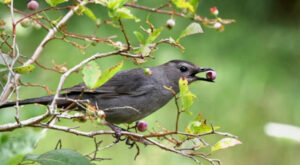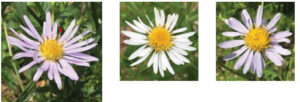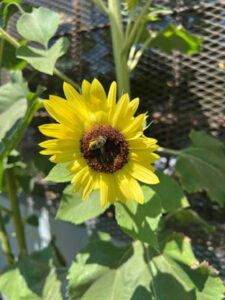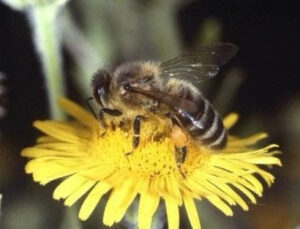by Dewey M. Caron, Communications and Content Specialist for the Oregon Master Beekeeper Program
The birds and the bees
 An estimated 3,600 species of wild bees serve as pollinators in the U.S. We believe, like many other populations of insects (and birds), bee populations are in decline. By combining abundant, largely citizen science gathered data, about birds (eBird participatory science project) with land cover data (USDA Cropland Data Layer), folks at the Cornell Ornithology Lab in Ithaca NY investigated if bird population data might be used as an indicator to conditions that might also impact bees.
An estimated 3,600 species of wild bees serve as pollinators in the U.S. We believe, like many other populations of insects (and birds), bee populations are in decline. By combining abundant, largely citizen science gathered data, about birds (eBird participatory science project) with land cover data (USDA Cropland Data Layer), folks at the Cornell Ornithology Lab in Ithaca NY investigated if bird population data might be used as an indicator to conditions that might also impact bees.
Their study combined these resources with publicly available data on bees (SCAN and GBIF data repositories) in the central and eastern US. By putting these three pieces of data together, they were able to demonstrate that birds add value to land cover data. They concluded this correlative data can indeed serve to forecast potential wild bee species richness across broad geographies. The bird data enables estimation of bee richness in places that don’t have direct observations of bee populations. Such information can help direct research to areas lacking information, guiding monitoring and conservation priorities until the quality and quantity of bee data is improved.
Rousseau, Josée, Alison Johnston and Amanda D. Rodewald. 2025. Where the wild bees are: Birds improve indicators of bee richness. journal.pone.0321496 https://doi.org/10.1371/journal.pone.0321496
Photo: The fruit-eating gray catbird can indicate the presence of flowering shrubs and trees that attract certain species of bees. (Photo: Jay McGowan/Cornell Lab of Ornithology)
Natives vs cultivars
 Planting native plants helps support pollinators like bees, butterflies and other beneficial insects. But when selecting plants there often is an option of a cultivar. A cultivar is a version or variety selected or bred to have certain traits, like different flower colors or shapes. Cultivars can look and behave a bit differently from the wild (native) versions. How can we determine which cultivar of a plant or if the native is best?
Planting native plants helps support pollinators like bees, butterflies and other beneficial insects. But when selecting plants there often is an option of a cultivar. A cultivar is a version or variety selected or bred to have certain traits, like different flower colors or shapes. Cultivars can look and behave a bit differently from the wild (native) versions. How can we determine which cultivar of a plant or if the native is best?
Jen Hayes, a recent Oregon State University graduate in Horticulture, set out to determine if pollinators preferred wild native plants or their cultivars. She did her studies at the OSU Oak Creek Center for Urban Horticulture, also home to the Oak Creek apiary, by collecting data over 3 years on bees, butterflies and flower flies to see what pollinators preferred and if specialist pollinators — those that rely on specific plants — chose wild natives more often.
What she found was that pollinator visits depended a lot on the specific plant and insect. When comparing native plants with their cultivars, pollinators favored the wild versions about 37% of the time and their cultivars only about 8% of the time. She says “The cultivars that had have higher visitation rates tended to be those minimally developed cultivars.”
Jen J-M Hayes , Nicole C Bell , Lincoln R Best , Svea R Bruslind , Devon O Johnson , Mallory E Mead , Tyler S Spofford and Gail A Langellotto. 2025, Pacific Northwest native plants and native cultivars, part I: pollinator visitation. Environmental Entomology, Volume 54 (1):199–214, https://doi.org/10.1093/ee/nvae126
Photo: Douglas Aster (left) with 2 cultivars popular for honey bees
Melittoflora data visualization tool
 The Melittoflora is a first-of-its-kind data visualization tool created by the Oregon Bee Atlas and the Oregon State University Extension Service Master Melittologist Program. A parallel program in Idaho has listed 727 bee species in Idaho and is hunting for additions. The Idaho program is part of OSU Master Melittologist program and viewable in the Mellitoflora site.
The Melittoflora is a first-of-its-kind data visualization tool created by the Oregon Bee Atlas and the Oregon State University Extension Service Master Melittologist Program. A parallel program in Idaho has listed 727 bee species in Idaho and is hunting for additions. The Idaho program is part of OSU Master Melittologist program and viewable in the Mellitoflora site.
The Melittoflora visualizes about 106,000 records of individual bees and plants they visit. It is the largest bee-plant interactive network in the world, according to Andony Melathopoulos, Associate Professor of pollinator health Extension in OSU’. It enables users to explore species occurrence records of bees interacting with flowering plants. This interactive website should greatly expand public awareness of the richness and diversity of Oregon bees.
Photo: leafcutter bee on sunflower
Pollen or bee bread
 Bees are junk food junkies. They only eat processed foods honey and bee bread. It is controversial whether the duration of time pollen has been converted to bee bread alters its palatability or nutritive value. A question from a mentee about bee preferences and value of stored bee pollen got me looking into bee dietary preferences. It turns out the fresh stuff is preferred but the stored stuff is just as nutritional, at least initially.
Bees are junk food junkies. They only eat processed foods honey and bee bread. It is controversial whether the duration of time pollen has been converted to bee bread alters its palatability or nutritive value. A question from a mentee about bee preferences and value of stored bee pollen got me looking into bee dietary preferences. It turns out the fresh stuff is preferred but the stored stuff is just as nutritional, at least initially.
Pollen collection at flower anthers requires the addition of honey or nectar and oral secretions to pollen granules for transport to the hive (Corbicular pollen). There it is tightly packed into cells (stored pollen, usually termed bee bread) and further coated with additional layers of nectar, honey, and oral secretions. Bee bread in cells eventually contains 40–50% simple sugars. Both corbicular pollen and stored pollen (bee bread) differ from anther pollen in that individual pollen grains are immersed in a sugar rich acidic matrix consisting of regurgitated honey and oral secretions.
Mark Carrol, Kirk Anderson and collaborators at the USDA Tucson lab monitored use of stored pollen/bee bread of known age for 8 days on 18 brood frames from 6 colonies. Despite a greater abundance of older stored pollen cells on brood frames, the bees showed a marked preference for the consumption of freshly-stored pollen. Two to four day-old pollen cell contents were significantly more likely to be consumed, while pollen cell contents more than seven days old were eaten at much lower rates.
Lab studies of caged bees yielded the same result. One day-old stored pollen was consumed two times more often than 5 day-old stored pollen and approximately three times more often than 10 day-old stored pollen.
The bees consumption preferences for freshly-stored pollen however did not provide a clear developmental advantage, according to the study. Young adult workers reared for 7 days on 1d-, 5d-, or 10d-old stored pollen showed no difference in body mass, stored pollen consumption, hindgut fecal material accumulation, or hypopharyngeal gland (HPG) protein titers, strongly suggesting that different-aged pollen stores did not vary in their nutritional value to adult bees.
While answering the question about seasonal bee preferences and nutritive value of recently collected pollen, the study did not address the value of pollen stored longer periods of time or bee bread value in the spring to overwintered colonies. They do say “stored pollen that is not eaten in the first few days accumulates as excess stores preserved in a less preferred, but nutritionally-similar state.”
Carroll, Mark J. Nicholas Brown, Craig Goodall, Alexandra M. Downs, Timothy H. Sheenan and Kirk E Anderson. 2017. Honey bees preferentially consume freshly-stored pollen. PLoS One, . 2017 Apr 21;12(4):e0175933. doi: 10.1371/journal.pone.0175933
Photo: Bee collecting pollen – packing it on hind legs begins the change from anther pollen to stored bee bread